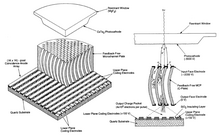Multi-anode microchannel array

A multi-anode microchannel array ( MAMA ) is a sensor for measuring particularly small streams of photons . It is particularly often used in space travel and astronomy .
description
A MAMA sensor essentially consists of four parts. First, the incoming photons pass through a window that, depending on the desired measuring range, consists of a material that is only transparent for certain wavelengths (e.g. magnesium fluoride for ultraviolet to near infrared radiation ). The photons that are not filtered out then hit a photocathode located on the underside of the window. This converts the photons into one or more electrons with the help of a thin semiconductor material (e.g. cesium iodide for the UV range), which are then passed into a microchannel plate . Here the initial shower of electrons is amplified according to the principle of a channel electron multiplier so that a downstream CCD sensor can precisely determine the time and intensity of the shower . With the knowledge of the properties of the individual components, it can be determined when and where a photon fell on the sensor. Since high-energy or short-wave photons trigger a stronger shower, conclusions can also be drawn about their wavelength. In combination with the possibility of two-dimensional spatial resolution, MAMA sensors are therefore particularly suitable for use in imaging spectrographs .